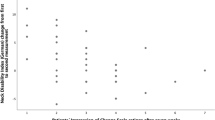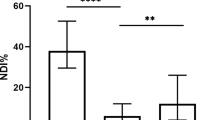Abstract
Background
Neck pain is a common health problem that restricts activities of daily living. The Neck Disability Index (NDI) was developed to assess disability in patients with neck pain. The normative score and the cut-off value are mandatory to assess an individual patient or a certain patient group for clinically important neck pain with disability, by distinguishing it from nonsignificant pain. The objective of the present study was to determine the normative score and the cut-off value of the NDI.
Methods
A total of 1,200 participants who registered with an internet research company were interviewed on the website about their episodes of neck pain during the previous 4 weeks, and completed the online NDI questionnaire. If the participants reported neck pain, they were also asked about the disability in activity of daily living it caused, and the presence of associated symptoms in upper limbs. Disability was defined according to the consensus study on the standardization of back pain definitions. The normative score was determined by calculating the mean in the participants, and the cut-off value was determined by the receiver-operating characteristic curve analysis.
Results
The prevalence of neck pain was 37.8 %. Demographic data of the participants also indicated that they were representative of the normal population in Japan. The mean score was 6.98, and the median was 2. The NDI score was higher in middle age, and at its peak in the 50s age group (50–59 years of age). The female mean was significantly higher. The NDI score was higher in those with upper limb symptoms. We have determined the cut-off value of the NDI to detect neck pain associated with disability to be 15.
Conclusions
The normative score and the cut-off value of the NDI were determined. Our cut-off value is potentially useful in evaluating the therapeutic effectiveness of various interventions for neck pain.



Similar content being viewed by others
References
Vernon H, Mior S. The Neck Disability Index: a study of reliability and validity. J Manipulative Physiol Ther. 1991;14:409–15.
Lee H, Nicholson LL, Adams RD, Maher CG, Halaki M, Bae SS. Development and psychometric testing of Korean language versions of 4 neck pain and disability questionnaires. Spine (Phila Pa 1976). 2006;31:1841–5.
Wu S, Ma C, Mai M, Li G. Translation and validation study of Chinese versions of the neck disability index and the neck pain and disability scale. Spine (Phila Pa 1976). 2010;35:1575–9.
Bunketorp L, Stener-Victorin E, Carlsson J. Neck pain and disability following motor vehicle accidents—a cohort study. Eur Spine J. 2005;14:84–9.
Atherton K, Wiles NJ, Lecky FE, Hawes SJ, Silman AJ, Macfarlane GJ, Jones GT. Predictors of persistent neck pain after whiplash injury. Emerg Med J. 2006;23:195–201.
Nederhand MJ, Ijzerman MJ, Hermens HJ, Turk DC, Zilvold G. Predictive value of fear avoidance in developing chronic neck pain disability: consequences for clinical decision making. Arch Phys Med Rehabil. 2004;85:496–501.
Miettinen T, Leino E, Airaksinen O, Lindgren KA. The possibility to use simple validated questionnaires to predict long-term health problems after whiplash injury. Spine (Phila Pa 1976). 2004;29:E47–51.
Sterling M, Jull G, Vicenzino B, Kenardy J. Sensory hypersensitivity occurs soon after whiplash injury and is associated with poor recovery. Pain. 2003;104:509–17.
Fairbank JC, Couper J, Davies JB, O’Brien JP. The Oswestry low back pain disability questionnaire. Physiotherapy. 1980;66:271–3.
Dionne CE, Dunn KM, Croft PR, Nachemson AL, Buchbinder R, Walker BF, Wyatt M, Cassidy JD, Rossignol M, Leboeuf-Yde C, Hartvigsen J, Leino-Arjas P, Latza U, Reis S, Gil Del Real MT, Kovacs FM, Oberg B, Cedraschi C, Bouter LM, Koes BW, Picavet HS, van Tulder MW, Burton K, Foster NE, Macfarlane GJ, Thomas E, Underwood M, Waddell G, Shekelle P, Volinn E, Von Korff M. A consensus approach toward the standardization of back pain definitions for use in prevalence studies. Spine (Phila Pa 1976). 2008;33:95–103.
Japanese Ministry of Health, Labour and Welfare. The report of the national health and nutrition examination survey in 2007; March, 2010; accessed 15 April 2012. http://www.mhlw.go.jp/bunya/kenkou/eiyou09/01.html (in Japanese).
Fejer R, Kyvik KO, Hartvigsen J. The prevalence of neck pain in the world population: a systematic critical review of the literature. Eur Spine J. 2006;15:834–48.
Hartvigsen J, Frederiksen H, Christensen K. Back and neck pain in seniors—prevalence and impact. Eur Spine J. 2006;15:802–6.
MacDermid JC, Walton DM, Avery S, Blanchard A, Etruw E, McAlpine C, Goldsmith CH. Measurement properties of the neck disability index: a systematic review. J Orthop Sports Phys Ther. 2009;39:400–17.
Stratford P, Riddle D, Binkley J, Spadoni G, Westaway M, Padfield B. Using the Neck Disability Index to make decisions concerning individual patients. Physiother Can. 1999;51:107–12.
Cleland JA, Fritz JM, Whitman JM, Palmer JA. The reliability and construct validity of the Neck Disability Index and patient specific functional scale in patients with cervical radiculopathy. Spine (Phila Pa 1976). 2006;31:598–602.
Pool JJ, Ostelo RW, Hoving JL, Bouter LM, de Vet HC. Minimal clinically important change of the Neck Disability Index and the Numerical Rating Scale for patients with neck pain. Spine (Phila Pa 1976). 2007;32:3047–51.
Kvien TK, Heiberg T, Hagen KB. Minimal clinically important improvement/difference (MCII/MCID) and patient acceptable symptom state (PASS): what do these concepts mean? Ann Rheum Dis. 2007;66(Suppl 3):iii40–1.
Kleinman L, Leidy NK, Crawley J, Bonomi A, Schoenfeld P. A comparative trial of paper-and-pencil versus computer administration of the Quality of Life in Reflux and Dyspepsia (QOLRAD) questionnaire. Med Care. 2001;39:181–9.
Boeckner LS, Pullen CH, Walker SN, Abbott GW, Block T. Use and reliability of the World Wide Web version of the Block Health Habits and History Questionnaire with older rural women. J Nutr Educ Behav. 2002;34(Suppl 1):S20–4.
Japanese Ministry of Internal Affairs & Communications. Communications Usage Trend Survey.; May, 2011; accessed 13 May, 2012. http://www.soumu.go.jp/johotsusintokei/tsusin_riyou/data/eng_tsusin_riyou02_2010.pdf.
Waddell G. Social interactions. In: The back pain revolution. 2nd ed. Edinburgh: Churchill Livingstone; 2004. p. 241–63.
O’Connor PJ. Normative data: their definition, interpretation, and importance for primary care physicians. Fam Med. 1990;22:307–11.
Nakamura M, Nishiwaki Y, Ushida T, Toyama Y. Prevalence and characteristics of chronic musculoskeletal pain in Japan. J Orhop Sci. 2011;16:424–32.
Acknowledgments
Federal funds were received in support of this work. Supported by a grant from the Japanese Ministry of Health, Labour and Welfare.
Author information
Authors and Affiliations
Corresponding author
About this article
Cite this article
Kato, S., Takeshita, K., Matsudaira, K. et al. Normative score and cut-off value of the Neck Disability Index. J Orthop Sci 17, 687–693 (2012). https://doi.org/10.1007/s00776-012-0276-y
Received:
Accepted:
Published:
Issue Date:
DOI: https://doi.org/10.1007/s00776-012-0276-y




